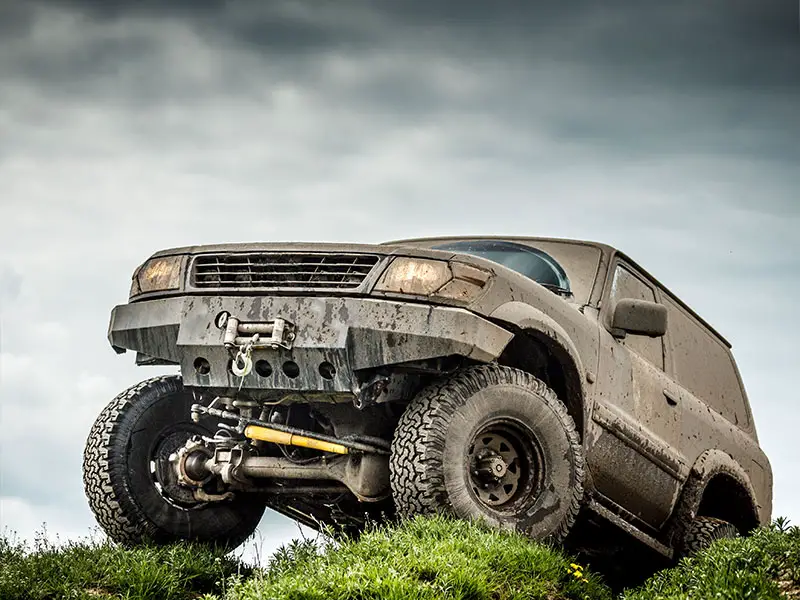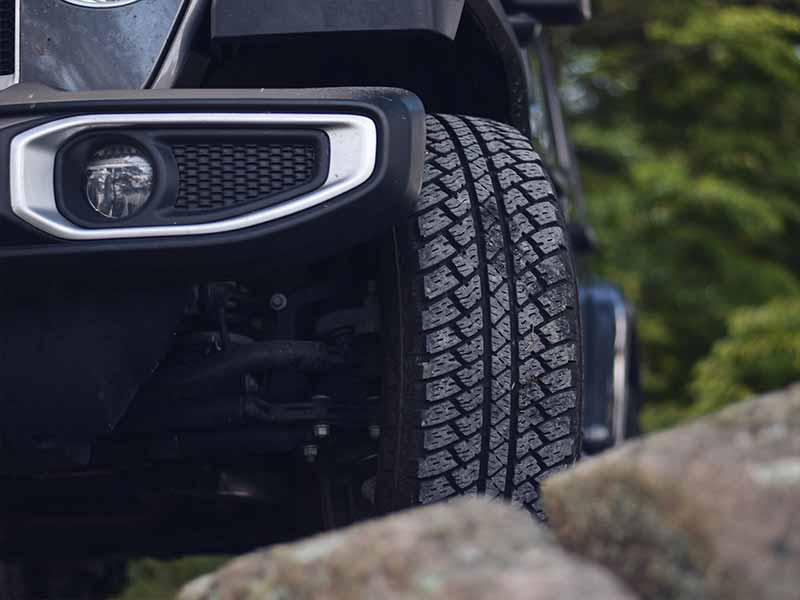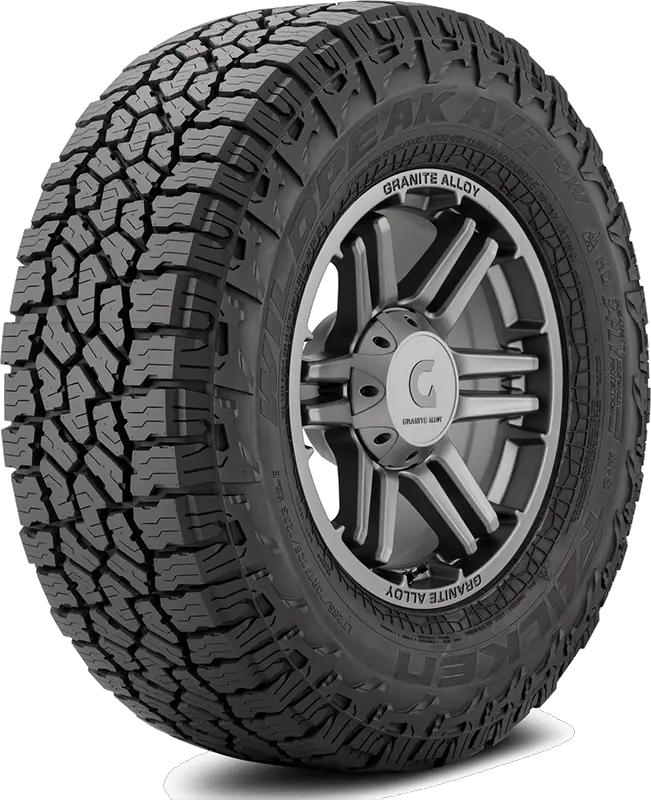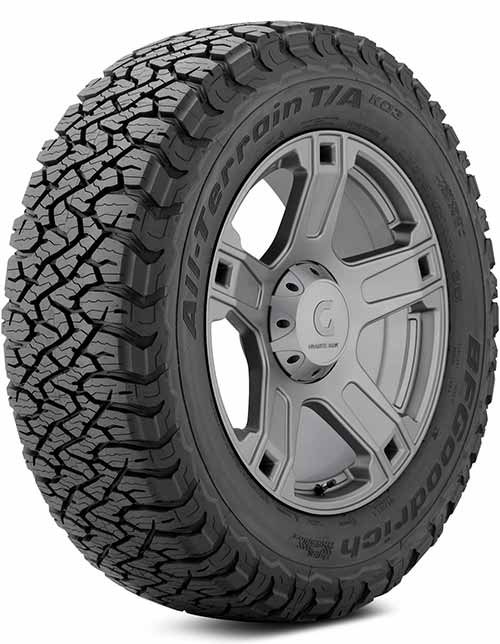Four wheel drive vehicles mainly differ from all wheel drive cars and trucks due to 4WD being more appropriate for off-road use. AWD may have some computer-controlled settings to help it cope with off-road conditions, but it isn’t the same a dedicated low gearing to deal with harsh terrain.
But how does this affect tire rotation patterns for 4WD? The truth is they’re largely the same. There may be some exceptions so you should refer to the vehicle manufacturer guidance in your owner’s manual just to be safe.
4WD Tire Rotation Pattern
There are two acceptable rotation patterns for four wheel drive vehicles. The rearward cross and X-pattern. The rearward cross is the more preferable method since it better distributes the tires around the car or truck over time.

Let’s cover the details of how to deal with rotating tires on 4WD cars and trucks.
4WD Tire Rotation Patterns (4×4)
4WD systems are not the same as all wheel drive, but they are very similar. The same rotation patterns for AWD work well with 4WD.
There may be situations where a 4WD system works in a unique way and the tires may benefit from a different pattern. Be sure to refer to the owner’s manual provided by your vehicle manufacturer for any unique requirements regarding tire rotation.
Rearward Cross Pattern
The most common tire rotation pattern used on four wheel drive vehicles is the rearward cross. This pattern moves the front tires rearward and across to the opposite sides of the car or truck.
The rear tires move forward but do not switch sides of the vehicle.
X-Pattern
The X-pattern is very popular and acceptable to with four wheel drive vehicles. It moves the front tires to the rear and across to the opposite sides of the car or truck. The rear tires move to the front and across to the opposite sides of the vehicle.
Best Tire Rotation Pattern For 4WD
The best tire rotation pattern for most four wheel drive vehicles is the rearward cross because it will eventually move every tire to every position and create the most even wear over time.
The X-pattern simply swaps the tires at opposite corners of the vehicle and those tires will never be placed in the other two positions unless the rotation pattern is changed.
How To Rotate Directional Tires On 4WD
Directional tires can only spin in one direction and must stay on the side of the car or truck they were meant to be used on. If they are moved to the opposite side of the vehicle they will be spinning in the wrong direction and this can be extremely dangerous, especially in wet conditions.
Because directional tires can’t switch sides, they can only be rotated front to rear.
Front To Rear
Front to rear tire rotation is fairly obvious. The front tires move to the rear without crossing to the opposite side of the vehicle. The rear tires then move to the front. Also, without changing sides of the car or truck.
How To Rotate Staggered Wheels On 4WD
Staggered wheels are wheels that are different sizes on the front and rear axles. Sometimes wider or larger wheels and tires are used on the rear to improve handling and traction.
These larger rear wheels and tires should not be moved to the front axle, and hopefully it’s obvious that the smaller front wheels shouldn’t move to the rear axle.
This means that the only pattern of rotation is side to side.
Side To Side
Side to side rotation is very simple. The front tires swap sides and the rear tires swap sides. They do not change which axle they are mounted on, only which end of the axle.
Side to side rotation is of relatively minor benefit but can still be helpful. Especially if your tire manufacturer will honor their tire warranty while you have staggered wheels and tires.
How To Rotate Tires On 4WD With Full Size Matching Spare Tire
Full size spare tires with wheels that match the four main wheels should be included in regular rotations and can make a big difference in the overall lifespan of the set of tires.
It also ensures the spare tire gets put to good use so that it doesn’t dry rot from age without using the tread depth.
The last important benefit is that the spare tire will be much more likely to be in good condition if you are in a situation where you need to use it. Non-matching spare tires often get forgotten about and can dry rot and lose air pressure over time. When you need your spare tire it may not be usable unless you are diligent about maintaining it.
Rearward Cross 5-Tire Rotation
The rearward cross 5-tire pattern is a modification of the standard rearward cross. The modification has the driver’s front move to the spare location and the spare go back into service at the passenger rear position.
Do You Need To Rotate Tires On 4WD
Tire rotation is usually required to maintain any tire warranty that a tire manufacturer may provide on a set of tires. Maintaining this warranty should be important to you as it can save you a lot of money.
Not all tires will come with a warranty, but you should still have your tires rotated to ensure that they wear as evenly as possible and last a long time.
How Often Should I Rotate 4WD Tires?
How often you should rotate your tires is determined by the tire manufacturer and will vary from tire to tire. Each tire manufacturer will specify a mileage interval to not exceed between tire rotations.
Tire manufacturers usually provide a mileage warranty for their tires and require that the tire rotation mileage not be more than the mileage they set if you expect them to honor any warranty claim.
This mileage amount is usually between 5,000 and 8,000 miles but varies for many reasons. I usually recommend rotating tires at 5,000 mile intervals since it usually will meet or exceed the tire manufacturer requirements.
You should always check the documentation that came with your tires for the mileage requirement you need to stay under between rotations. You should also review the paperwork for any additional requirements to maintain your tire warranty and get the most life out of your tires.
4WD Vs 4×4 Vs AWD Vs Full Time 4WD
The terms four wheel drive, four by four, all wheel drive, and full-time four wheel drive get thrown around a lot and often get used improperly.
The overwhelming majority of these systems, regardless of the name, will use rearward cross or x-pattern rotation. This is because almost all will produce more wear on rear tires than front. There may be some front bias systems or some that wear the front tires more and those may benefit from the forward cross pattern.
Refer to your owner’s manual to see what patterns they recommend.
Let’s break down what each means as clearly as possible.
Four By Four (4×4)
This basically means that all four tires are being used to propel the vehicle forward. This is the parent category for all of the other names.
Four Wheel Drive (4WD)
Typically, 4WD is a feature that allows a two wheel drive to mechanically engage the other axle and become a four wheel drive vehicle.
Full-Time Four Wheel Drive
Full-time four wheel drive cars and trucks are essentially 4WD without the ability to mechanically disable an axle and convert to 2WD. They do usually include the ability to select 4Hi or 4Lo which is a mechanical setting that changes gearing from road and highway use to off-road appropriate gearing.
All Wheel Drive (AWD)
All wheel drive is the most modern system of 4×4 in some regards, but removes adjustability from the driver. All wheel drive vehicles don’t have a dedicated gearing for off-road purposes and aren’t designed for more demanding off-road situations.
They do tend to be more advanced in that they often rely on computer programming and the use of sensors to adjust grip at each of the four corners of the vehicle. They replace a lot of the dedicated mechanicals with these computer-controlled systems.
Final Thoughts
Tires are expensive. Four wheel drive off-road tires are very expensive. If you want to get the most tread life out of them, be sure and have them rotated.
Special-purpose tires are less likely to have a warranty. Tire rotation is usually a requirement to prevent your warranty from becoming voided. But if you don’t have a warranty, don’t think that means you can skip rotating your tires. It’s even more important now that you don’t have a warranty to fall back on.
Be sure and follow the guidance of your vehicle manufacturer and the guidance of your tire manufacturer when it comes to tire maintenance. Get the most out of them you can and save yourself some cash in the process.
Resources
Below are some links you may find helpful when learning about tires





